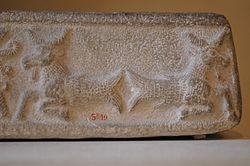Greek interpretation
The Greek interpretation of the sea goat comes from the introduction of the Babylonian zodiac. In an attempt to codify the constellation Capricornus within the Greek pantheon, two myths were used as an explanation. One being that the constellation is Amalthea, the goat that raised Zeus. As thanks for caring for him as a child, Zeus places her amongst the stars. [5]
The other being that the sea goat is the wilderness god Pan. [6] The myth goes that Pan jumped into the river to escape the monster Typhon. He tries to turn himself into a fish while jumping into the river, but he moves too quickly and only his lower half becomes that of a fish. Zeus then engages in combat with the monster. Zeus defeats him, but not without Typhon pulling the muscles out of Zeus' legs. With the help of Hermes, Pan replaces the damaged muscles. As a reward for healing him, Zeus placed Pan in the sky as Capricorn. [7] The god Aegipan is also depicted in Greek art as a sea goat.
Imagery found at Aphrodisias, including coins dating back to the 3rd century AD, depict the goddess Aphrodite riding a sea goat. [8]
This page is based on this
Wikipedia article Text is available under the
CC BY-SA 4.0 license; additional terms may apply.
Images, videos and audio are available under their respective licenses.

